Dogs used to be bred for working, pulling sleds in mines or hunting game. But times have changed..
And now more than ever dogs are a ‘man’s best friend’ – sitting at our side as companions rather than workers.
As dogs a role has changed so has the way that we feed them.
However this change has seen a number of new challenges come up for dogs, one of those being obesity.
Obesity is ranked as one of the top concerns for vets across the country.
In fact, the PDSA reports that vetinarians would classify 49% of all dogs as being obese.
This change has come about because of two fierce forces… food portions are increasing and exercise is decreasing.
That’s why Dr Lazaris’ latest video is one of the most important pet owners should watch.
Not only will it show you the quick checks you can try on your pet, it will reveal a few simple things you can do to keep them fit as a butchers dog…
Dr Lazaris’ 3 Simple Checks For Obesity
If you aren’t sure if you dog is overweight you can use the 3 step check on your dog here:
- You should be able to see and feel the outline of your dog’s ribs.
- You should be able to see and feel your dog’s waist, and this should be clearly visible from above.
- A dog’s belly should be tucked up when viewed from the side.
If your dog has struggled to pass these three checks they might be suffering from an obesity problem.
The Risks Of Obesity
Obesity can have a devastating effect on your dog’s health and welfare. It can cause several health problems and make existing health problems worse.
That’s why this is something that is so important to focus on.
Because dogs who becomes obese have shorter lifespans and are more at risk of chronic illnesses.
Dogs that suffer with obesity have a higher risk of:
- Diabetes
- Heart disease
- Respiratory disease
- High blood pressure
- Arthritis
- Cancers
Often, the causes of obesity are preventable and it can be avoided by simple changes to your dog’s lifestyle.
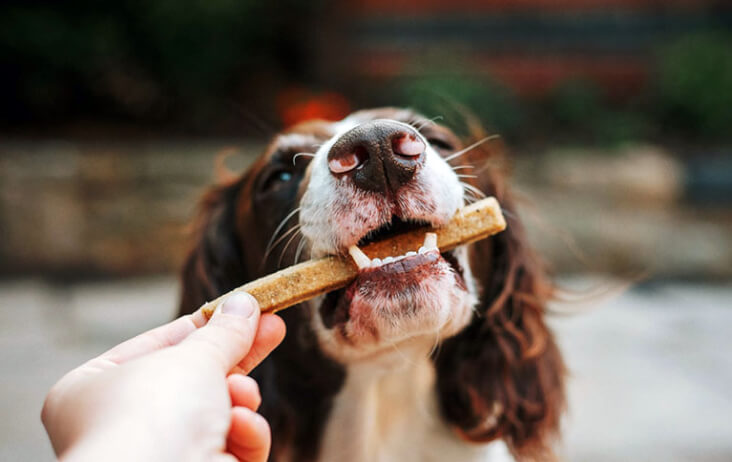
How Likely Is My Dog To Become Obese?
Obesity can be a result of many different things. Often it occurs because of a combination of these factors.
Some factors are biological, such as your dog’s breed. Others are environmental, such as how many treats you feed your dog.
The cause of obesity is an outbalance between energy intake and energy expenditure. In other words, if your dog is taking in more calories than he can burn off he will put on weight.
And if a dog is overweight as a puppy, he is more likely to gain weight easily as an adult.
Let’s jump in and explore the factors that can contribute to obesity in dogs…
| Biological Factors | Environmental Factors |
| Age As a dog gets older they will begin to require less and less calories each day. That’s because a dog’s energy levels decrease with age. Puppies need more calories than adult dogs. And older dogs should be put on a senior food that contains less calories and fat. | Activity and exercise level As is the same with humans, the more a dog exercises, the more energy they will use each day. And the more energy they use each day, the more calories they will need. Working dogs require a diet higher in calories for this reason. |
| Breed Certain breeds can be more at risk of becoming obese. These include Labrador Retrievers, Golden Retrievers, Cocker Spaniels, Beagles and Pugs. If you have one of these breeds, you should keep a careful eye on your dog’s weight. Minimise high calorie food and snacking. | Food Intake Have you ever heard of the term ‘wolfed it down’? It may seem obvious that if you overfeed your dog, they will become overweight. But sometimes you might not realise they are eating too much. Dogs are natural scavengers in the wild, so it is normal for them to eat everything they find – even if they aren’t hungry. For this reason, it is important to stick to set meals and not leave food down all the time. The best way is to follow the recommended serving sizes on your dog food packaging. Don’t put any more food than this into your dog’s bowl. If your dog seems to always be hungry, try adding vegetables like carrots or green beans to their meals. These can bulk out your dog’s portion size without adding too many extra calories. |
| Neuter status Neutering is a surgical procedure carried out to prevent dogs from reproducing. When a dog is neutered, their metabolic rate will slow down. This means that the energy they require will decrease. Neutered dogs might put on weight if their diet isn’t adjusted to this change accordingly. | Quantity of treats given Giving too many treats or unhealthy foods is a key cause of weight gain in dogs. On days where your dog might be having more treats than usual, reduce the portion size of their meals. This will balance out calorie intake. Food scraps from the table can also be high in calories and unwanted fat and should be given sparingly, if at all. Make sure that children know not to feed their leftovers to the dog. A slice of buttered toast to a Cocker Spaniel is the same as two packets of crisps to a human. A digestive biscuit to a Jack Rusell is almost equivalent to a human eating a whole portion of chips! If you want to give your dog treats, try carrot, apple or rice cakes, which are all low in calories. A carrot given whole can also be a fun alternative to a high calorie chew! |
| Medical Conditions It is unlikely that your dog’s obesity will be caused solely by a medical problem. But some medical conditions can make it more likely that your dog will gain weight. These include underactive thyroid and Cushing’s disease. | Sharing The Home If you have more than one dog, it might be a good idea to feed them in separate rooms. This is because dogs have a natural survival instinct to protect their food. They might eat more than they need to if they think that another dog is threatening to take it away from them. |
| Personality Your dog might only eat what they need when they are hungry. Other dogs will keep eating what is put in front of them even once they’re full. Some dogs might also be fussy, reducing their food intake. |
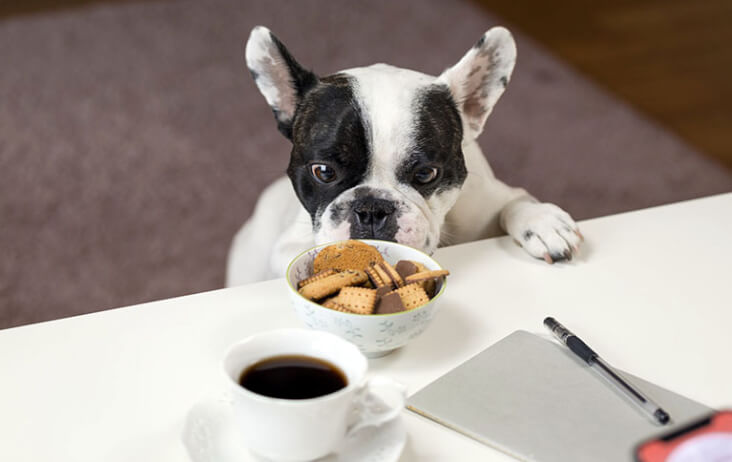
I Think My Dog Might Be Overweight. What Should I Do?
At this point, you may be wondering what you can do if you think your dog is overweight.
If you’ve assessed your dog and decided that they might be heavier than they should be, the first thing you should do is contact your vet.
If the vet thinks that your dog is overweight, they will likely suggest that you create a plan together to help get them healthy again.
Sometimes, the vet can offer special food designed to promote weight loss. This will reduce the amount of calories in your dog’s diet but still provide the correct nutrients.
A vet might also be able to recommend further support. Many places offer weight reduction support groups for you and your dog.
Imagine Weight Watchers, but for dogs!
It is also sometimes a good idea to keep a food diary. This will allow you to identify where any extra, unwanted calories might be coming from and cut them out.
Putting Your Dog On A Diet
Humans will often put themselves on a diet to lose weight. And dogs are no different.
If your dog is overweight or obese, a diet is the best option for them.
Your vet will be able to help you decide on a suitable diet plan for your dog.
Some people might decide to feed smaller portions of their dog’s current food. But this can sometimes cause problems. The recommended serving size of dog food is designed to give your dog all the nutrients they need per day. If this serving size is reduced, they might not get these.
The second approach is to feed a food with less calories but the same nutritional value. Often a veterinarian can prescribe food like this to overweight dogs.
If you are trying to reduce your dog’s weight, you should stop feeding snacks and treats (except for training). The treats you do use should be low in calories, such as small pieces of apple or carrot.
Weight reducing diets should be combined with a good level of exercise. If your dog loves to swim this can be a great way to get them more active.
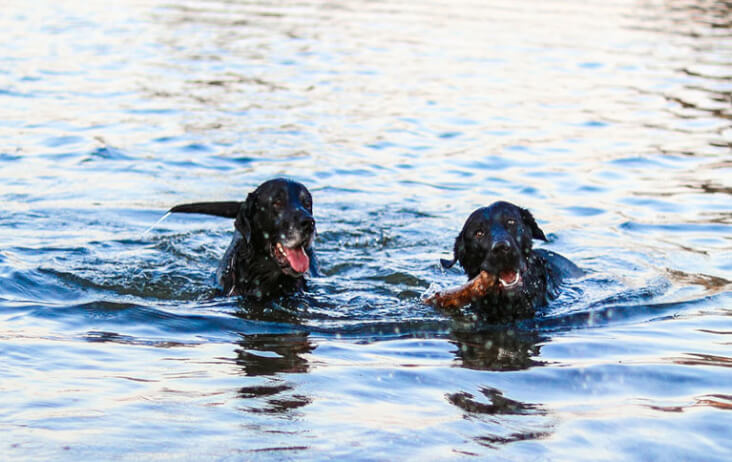
How To Keep Your Dog Active And Healthy
Keeping your dog active every day is important to avoid weight gain.
The easiest way to get your dog active is on daily walks. But sometimes the weather might be too hot for a long walk (see our ‘How To Help Your Dog In The Summer Sun’ post for advice). Or if the weather is bad, maybe you have to cut your daily outdoor exercise short.
Luckily there are some great activities that can get your dog active inside the home.
Here are a few ideas…
Fetch
If you have a long landing or spacious living room, games of fetch can transfer indoors quite easily (but you might want to use a soft toy for minimal damage to your furniture).
Obstacle Courses
If you have the space, setting up an indoor obstacle course can be great fun for both you and your dog. Jumping over chairs, under tables and even through a hula hoop can provide lots of enjoyment.
Food dispensing toys
Food dispensing toys can be found in most pet shops or online. They provide great stimulation for your dog with the most satisfying reward – food! Just make sure to take any calories given away from your dog’s daily meals.
Hide and Seek
You can play hide and seek with your dog by hiding tasty treats around the house for them to sniff out. This will keep them entertained and active as they run around to search for the treats! Just remember to take the extra calories away from their daily meal.
A Final Note…
All dog owners want to keep their pooch happy and healthy. And making sure they are the correct weight is one of the ways to do this.
The truth is, each dog is different. Whether you feed dry kibble, wet food or raw, the key is to stay understanding of your dog’s needs.
Your veterinarian can help if your dog seems to have an obesity problem.
After all, if they are a happy, healthy weight you will both have more fulfilment during your time together.
References
Case, Daristotle, Hayek and Raasch, ‘Canine and Feline Nutrition’ (1995).
Eldredge, Carlson, Carlson and Griffin, ‘Dog Owner’s Home Veterinary Handbook’, 4th Edition (2007).
https://www.bluecross.org.uk/pet-advice/dog-dieting-tips
https://www.thekennelclub.org.uk/media/770255/managing_your_dogs_weight.pdf
https://petcube.com/blog/indoor-dog-exercise/

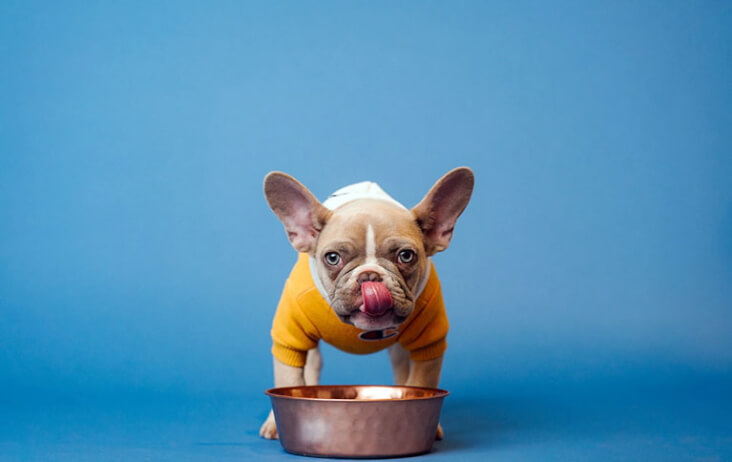




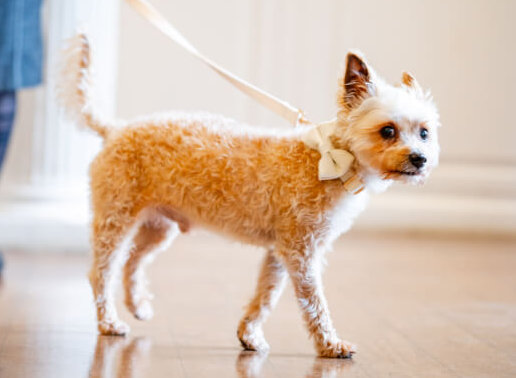
Comments